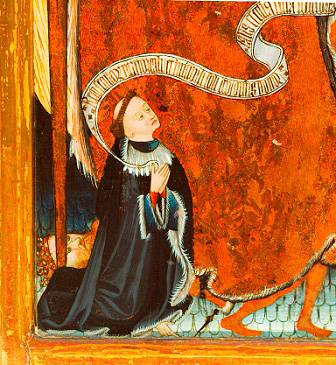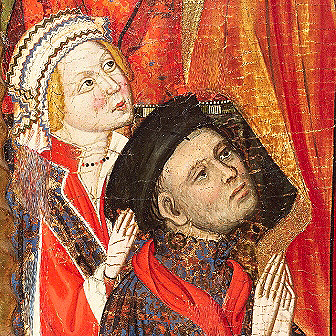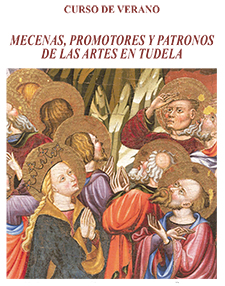PATRONS, PROMOTERS AND PATRONS OF THE ARTS IN TUDELA
26 August 2014
Three exceptional retablos for three promoters
Mrs. Mercedes Jover Hernando. Museum of Navarra
A The cathedral of Tudela treasures a set of Gothic altarpieces: the altarpiece of Santa Catalina, the altarpiece of Nuestra Señora de la Esperanza and the main altarpiece. They are considered exceptional for their beauty and artistic quality, for their patrimonial value -as they are the first Gothic altarpieces preserved in Navarre-, for the wide knowledge we have about them and for their promoters. All of them are in the chevet of the temple of Tudela.
The altarpiece of Santa Catalina is part of the International Gothic style. Marisa Melero dates it between 1408 and 1416 and is the work of a workshop familiar with the art of Juan de Leví and Pere Rubert, dependent on what was being done at that time in the cathedral of Tarazona, the diocese to which Tudela belonged. We do not know who was its promoter, who was portrayed as a member of the clergy in the central table, holding in his hand a phylactery where you can read the beginning of the first letter of St. Paul to Timothy, in Latin. We know that its initial location was the now disappeared Chapel of the Nuptials, located at the foot of the then Collegiate Church of Santa Maria de Tudela. In 1929 it traveled to the Universal exhibition of Barcelona and upon its return it was installed behind the grille of the Villaespesa Chapel, where it remained until 1971, when it was moved to its current location.

Altarpiece of Santa Catalina. Detail
Between 1408 and 1416
The altarpiece of Nuestra Señora de la Esperanza is a documented work, signed in 1412 by the Zaragozan Bonanat Zahórtiga. It is also framed in the International Gothic style. It offers an ambitious iconographic program, with a triple cycle: the one dedicated to San Francisco de Asís, iconographic rarity in this chronology, that it is necessary to attribute to the onomastics of its promoter; the one dedicated to San Gil, holder of the primitive invocation of the chapel and third, that in turn is double: Marian and Christological, in which the central panel stands out, where we find a beautiful Virgin of the O, next to which the promoters of the altarpiece are portrayed in a praying position: Francés de Villaespesa, a man core topic in the court of Carlos III and his wife, Isabel de Ujué, from Tudela. It presides over his funeral chapel.

Altarpiece of Our Lady of Hope, work of Bonanat Zahórtiga, 1412.
Detail of Francés de Villaespesa and his wife Isabel de Ujué, promoters of the altarpiece.
The High Altarpiece is also a well-documented work, executed between 1487 and 1494. Its main author is Pedro Díaz de Oviedo and corresponds to the Tardogothic style, also known as Hispano-Flemish Gothic. It was made at the request of the Chapter of the Collegiate, being bishop of Tarazona and dean of the Collegiate of Tudela Andrés Martín Férriz. With this action the chapter wanted to modernize the main chapel of the temple, which still presided over the White Virgin, an imposing Romanesque carving in polychrome limestone from around 1200. Behind the altarpiece were the 13th century Mudejar credenzas studied by Manuel Gómez Moreno, of which only a few fragments remain and are exhibited in the Museum of Navarre.
PROGRAM
Tuesday, 26th August
Three exceptional altarpieces for three promoters
Ms. Mercedes Jover Hernando. Museum of Navarre
The great patrons of the Renaissance, a mirror of humanism
María Concepción García Gainza. Chair of Navarrese Heritage and Art
Wednesday, 27th August
Around the patron saints
D. Ricardo Fernández Gracia
Chair of Navarrese Heritage and Art
Patrons and patrons of Tudela silverware
D. Ignacio Miguéliz Valcarlos
UNED Pamplona
Patrons and Patronages in the Collegiate ( visit guidada)
Ms. María Josefa Tarifa Castilla. University of Zaragoza
Thursday, 28th August
Town planning and civil architecture
D. Carlos Carrasco Navarro. Doctor in History of Art
The great men of the Enlightenment
D. Pablo Guijarro Salvador. Chair of Navarrese Heritage and Art.
Monarchy, patrons and nuns in the Company of Mary ( visit guided)
D. Ricardo Fernández Gracia
Chair of Navarrese Heritage and Art

